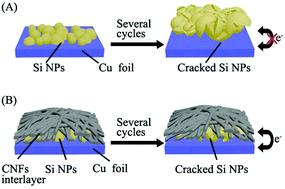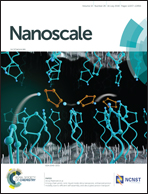Carbon nanofiber interlayer: a highly effective strategy to stabilize silicon anodes for use in lithium-ion batteries†
Abstract
Silicon (Si) possesses the highest theoretical capacity as an anode material for lithium-ion batteries, and many efforts have been made to address the poor cycling stability issue that is associated with its huge volume changes during Li–Si alloying/de-alloying processes, mostly through the design of nanostructured materials. Herein, we report a simple cell configuration approach to improve the lithium storage performance of commercial nano-Si through the insertion of carbon nanofiber films (CNFs) as interlayers between the Si electrodes and separators. For this advanced cell configuration, commercial Si nanoparticle (Si NP) electrodes demonstrate a significantly improved reversible capacity (2700 mA h g−1 after 40 cycles at 50 mA g−1) and an ultralong cycle life (1250 mA h g−1 after 430 cycles at 1500 mA g−1). Even when cycled at 4 A g−1, the material still demonstrates a very high capacity of 870 mA h g−1. The excellent electrochemical performance of the Si NPs is attributed to the novel cell configuration. Macropores between the carbon nanofibers provide good access of the electrolyte to the Si NP electrodes. The 3D interconnected networks of the CNF interlayer not only decrease the internal charge transfer resistance and enhance the electron transport rate but also offer electron pathways along the CNF interlayer for cracked and disconnected Si NPs after cycling.



 Please wait while we load your content...
Please wait while we load your content...